Breast
Oral
Body: Breast, Chest, Abdomen, Pelvis
Monday, 18 June 2018
| W03/04 |
08:15 - 10:15 |
Moderators: Ileana Hancu, Savannah Partridge |
08:15
 |
0092.
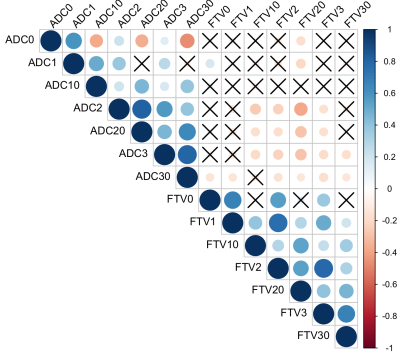 |
 The role of diffusion-weighted MRI in the prediction of response in I-SPY 2 TRIAL The role of diffusion-weighted MRI in the prediction of response in I-SPY 2 TRIAL
Wen Li, Lisa Wilmes, David Newitt, John Kornak, Ella Jones, Savannah Partridge, Jessica Gibbs, Bo La Yun, Matthew Tanaka, Laura Esserman, Nola Hylton
Diffusion weighted MRI can be used to characterize water mobility and cellularity of tumor by measuring the apparent diffusion coefficient (ADC). Functional tumor volume (FTV) measures size change along the treatment. This study showed that after only 3 weeks of pre-surgery chemotherapy, ADC added value to the logistic regression model of using FTV alone to predict pCR or RCB as outcomes for patients with advanced breast cancer in I-SPY 2 TRIAL. The effect of adding ADC is statistically significant and increase the estimated area under the ROC curve after adjusted for breast cancer subtype categorized by HR and HER2 status.
|
08:27
|
0093.
 |
 ACRIN 6702 DWI Trial: The Value of Alternate ADC Metrics Compared to Standard ADC for Decreasing Breast MRI False-Positives ACRIN 6702 DWI Trial: The Value of Alternate ADC Metrics Compared to Standard ADC for Decreasing Breast MRI False-Positives
Habib Rahbar, Zheng Zhang, Justin Romanoff, Lucy Hanna, Christopher Comstock, Savannah Partridge
The ACRIN 6702 trial confirmed that standard ADCs from multi b-value DWI acquisition are lower in malignancies than in benign lesions and that application of standard ADCs can eliminate one in five unnecessary biopsies. Secondary analysis from this trial demonstrated that application of alternate ADC metrics, including perfusion insensitive ADCØ and normalized ADC provide no practical benefit over standard ADC for improving conventional DCE-MRI performance. These findings suggest that standard ADC calculations alone are sufficient for improving breast MRI specificity and should be the primary metric included in the next edition of the BI-RADS atlas.
|
08:39
 |
0094.
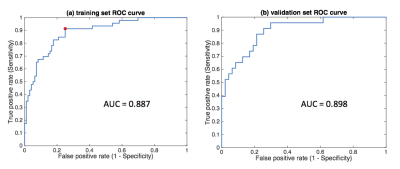 |
 DCE-MRI based radiomics signature: a potential biomarker for preoperative prediction of sentinel lymph node metastasis in breast cancer DCE-MRI based radiomics signature: a potential biomarker for preoperative prediction of sentinel lymph node metastasis in breast cancer
Jie Ding, Chunling Liu, Karl Spuhler, Tim Duong, Changhong Liang, Shahid Hussain, Chuan Huang
This study is the first to combine DCE-MRI radiomics with clinical information to predict sentinel lymph node (SLN) metastasis in breast cancer. The prediction model was established in a training set, and was further validated in a completely independent validation set, with AUC of 0.898 and negative predictive value of 0.902. This prediction performance surpasses the previous study using T2w and DWI, and is particularly useful for eliminating the unnecessary, invasive SLN biopsy and axillary dissection in patients with negative SLN, offering a step towards precision medicine of breast cancer.
|
08:51
 |
0095.
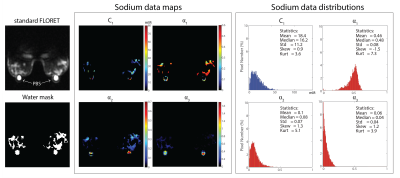 |
 Multi-compartmental sodium quantification in breast using a bilateral dual-tuned proton/sodium coil and multi-pulse excitation scheme at 7T Multi-compartmental sodium quantification in breast using a bilateral dual-tuned proton/sodium coil and multi-pulse excitation scheme at 7T
Carlotta Ianniello, Guillaume Madelin, Ryan Brown
Sodium is an important electrolyte in the human body and is a distinct MRI contrast mechanism in breast cancer as it provides insight on cellular viability, ion homeostasis, inflammation, and fluid content. Due to sodium low SNR, intracellular sodium concentration (C1), volume fractions for the intracellular (α1) or extracellular compartments (α2), and fluid (α3) remain largely unexplored. We built a custom bilateral dual-tuned 1H/23Na RF coil and developed a novel fingerprinting-based sodium excitation scheme on a 7T system to enable multi-compartmental sodium quantification in breast. In this work we describe the coil, pulse sequence and preliminary results in one subject.
|
09:03
 |
0096.
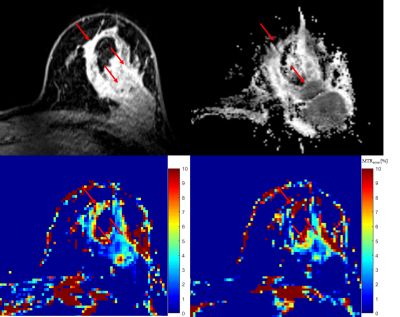 |
 CEST MRI – a potential tool for breast cancer grade and proliferation rate differentiation CEST MRI – a potential tool for breast cancer grade and proliferation rate differentiation
Olgica Zaric, Alex Farr, Esau Poblador Rodriguez, Vladimir Mlynarik, Claudia Kronnerwetter, Benjamin Schmitt, Wolfgang Bogner, Christian Singer, Siegfried Trattnig
I this study, we investigated which CEST contrast changes are characteristic and dominant for breast malignancies. In 18 female patients, we performed DWI, CEST imaging, and T1-CE MRI. Significant differences in MTRasym between G1 and G3 was found (P= 0.007). Between G1 and G2 (P=0.066) as well as between G2 and G3 no difference were observed (P= 0.089). Correlation test demonstrated a strong positive correlation between mean MTRasym measured in region of its maximum and proliferation factor, Ki-67 (r=0.890, P?0.001). This preliminary results show that CEST-MRI of the breast has a potential to provide information regarding the tumor histological features.
|
09:15
|
0097.
 |
ACRIN 6702 Multisite Breast DWI Trial: Comparison of Site vs. Centralized ADC Measures and Factors Affecting Data Quality
Video Permission Withheld
Savannah Partridge, Zheng Zhang, Jennifer Whisenant, Averi Kitsch, Justin Romanoff, Habib Rahbar, Thomas Yankeelov, Thomas Chenevert
Diffusion-weighted imaging (DWI) shows potential to improve lesion characterization and diagnostic performance of conventional contrast-enhanced breast MRI. Promising preliminary data from the ACRIN 6702 multisite trial show that DWI can reduce false-positive breast MRIs. Comparison of independently performed site and centrally-measured ADC values showed reasonable agreement, but suggest that further standardization of DWI interpretation and analysis tools across sites could improve diagnostic performance. Results also show more work is needed to address image quality issues and increase utility for measuring ADC values in MRI-detected breast lesions.
|
09:27
|
0098.
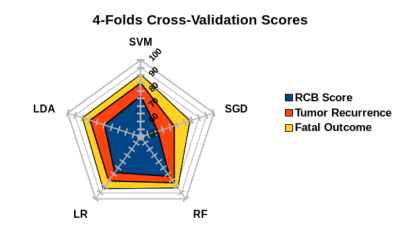 |
 Radiomics with magnetic resonance imaging of the breast for early prediction of response to neo-adjuvant chemotherapy in breast cancer patients Radiomics with magnetic resonance imaging of the breast for early prediction of response to neo-adjuvant chemotherapy in breast cancer patients
Katja Pinker-Domenig, Amirhessam Tahmassebi, Georg Wengert, Thomas Helbich, Zsuzsanne Bago-Horvath, Sousan Akaei, Elisabeth Morris, Anke Meyer-Baese
Breast cancer patients that achieve pCR after NAC have a significantly improved DFS and OS. The aim of this study was to assess radiomics with multiparametric MRI using DCE and T2w imaging for the early prediction of pCR to NAC in breast cancer patients. In 41 women radiomics analysis of MRI data was performed. Histopathology using the Residual Cancer Burden (RCB) score and class were the standard of reference. Radiomics analysis of MRI achieved AUCs for RCB score (AUC 0.85), metastases (AUC 0.87) and death (AUC 0.92). Radiomicswith multiparametric MRI enables prediction of response to NAC with high accuracy.
|
09:39
|
0099.
 |
 Ultrafast Dynamic Contrast Enhanced MRI of the Breast Using DISCO: Are the Quantitative Parameters Helpful in Differentiating between BI-RADS 4 and 5 Subcentimeter Invasive Carcinomas and Benign Lesions? Ultrafast Dynamic Contrast Enhanced MRI of the Breast Using DISCO: Are the Quantitative Parameters Helpful in Differentiating between BI-RADS 4 and 5 Subcentimeter Invasive Carcinomas and Benign Lesions?
Natsuko Onishi, Meredith Sadinski, Katherine Gallagher, Brittany Dashevsky, Theodore Hunt, Blanca Bernard-Davila, Danny Martinez, Amita Shukla-Dave, Elizabeth Morris, Elizabeth Sutton
The quantitative parameters derived from ultrafast dynamic contrast enhanced (UF-DCE) breast MRI using DISCO were analyzed for the assessment of possible utility in the differentiation between subcentimeter invasive carcinoma and benign lesions. Of all these parameters (MS, CER, IAUGC, BAT and Ktrans), BAT was the only parameter that predicted subcentimeter invasive carcinoma. We believe the significantly shorter BAT for subcentimeter invasive carcinomas is congruent with the known pathophysiology of cancer and may reflect its increased vascularity or shunt formation. BAT can be a complementary parameter to conventional steady-state DCE MRI, which could further stratify subcentimeter BI-RADS 4 and 5 lesions.
|
09:51
|
0100.
|
Lymph node multi-parametric MRI characteristics of responders and non-responders of neoadjuvant chemotherapy
Video Permission Withheld
Renee Cattell, James Kang, Silu Han, Thomas Ren, Pauline Huang, Haifang Li, Jules Cohen, Paul Fisher, Roxanne Palermo, Tim Duong
In the I-SPY 1 breast cancer clinical trial, change in size of the primary in-breast tumor in response to neoadjuvant therapy was a strong predictor of pathologic complete response. In this study, I-SPY 1 MRI lymph node characteristics was studied. Lymph nodes of patients who achieved pathologic complete response after chemotherapy had different characteristics from those who have residual disease in the tumor bed. The percent change of the signal enhancement ratio of each individual lymph node was the best parameter to differentiate between pathologic complete responders versus incomplete or non-responders.
|
10:03
|
0101.
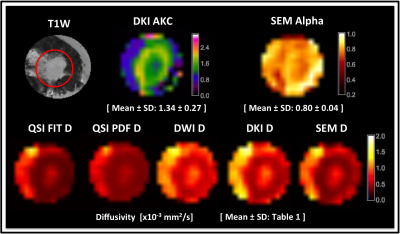 |
 Evaluation of microstructure heterogeneity from diffusion q-space imaging (QSI), diffusion weighted imaging (DWI) and non-Gaussian diffusion models in whole breast tumour Evaluation of microstructure heterogeneity from diffusion q-space imaging (QSI), diffusion weighted imaging (DWI) and non-Gaussian diffusion models in whole breast tumour
Nicholas Senn, Yazan Masannat, Ehab Husain, Bernard Siow, Steven Heys, Jiabao He
QSI was compared against conventional DWI and non-Gaussian diffusion models, namely diffusion kurtosis imaging (DKI) and stretched-exponential model (SEM) to evaluate diffusivity heterogeneity for profiling breast tumour cell diversity. We investigated whole breast tumours excised from surgery, with imaging performed overnight on the same day on a clinical system. Asymmetry in diffusivity distribution was quantified as histogram skewness, median and 25th-percentile. Correlation analysis was performed to compare QSI against other models. The skewness of diffusivity distribution derived from QSI was the highest among the models and provided a wider spread of values across cohort, allowing more sensitive clinical applications.
|
|












